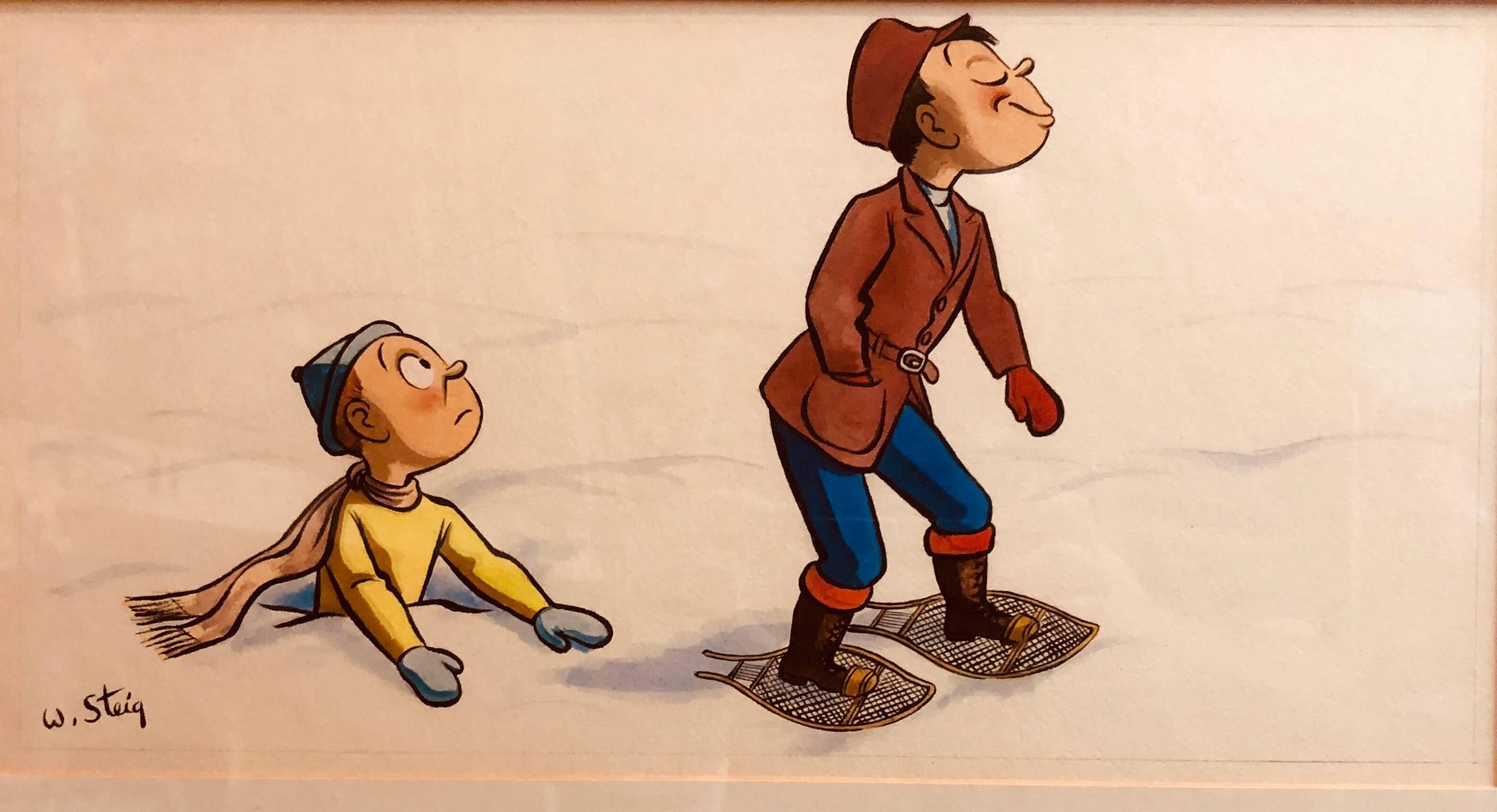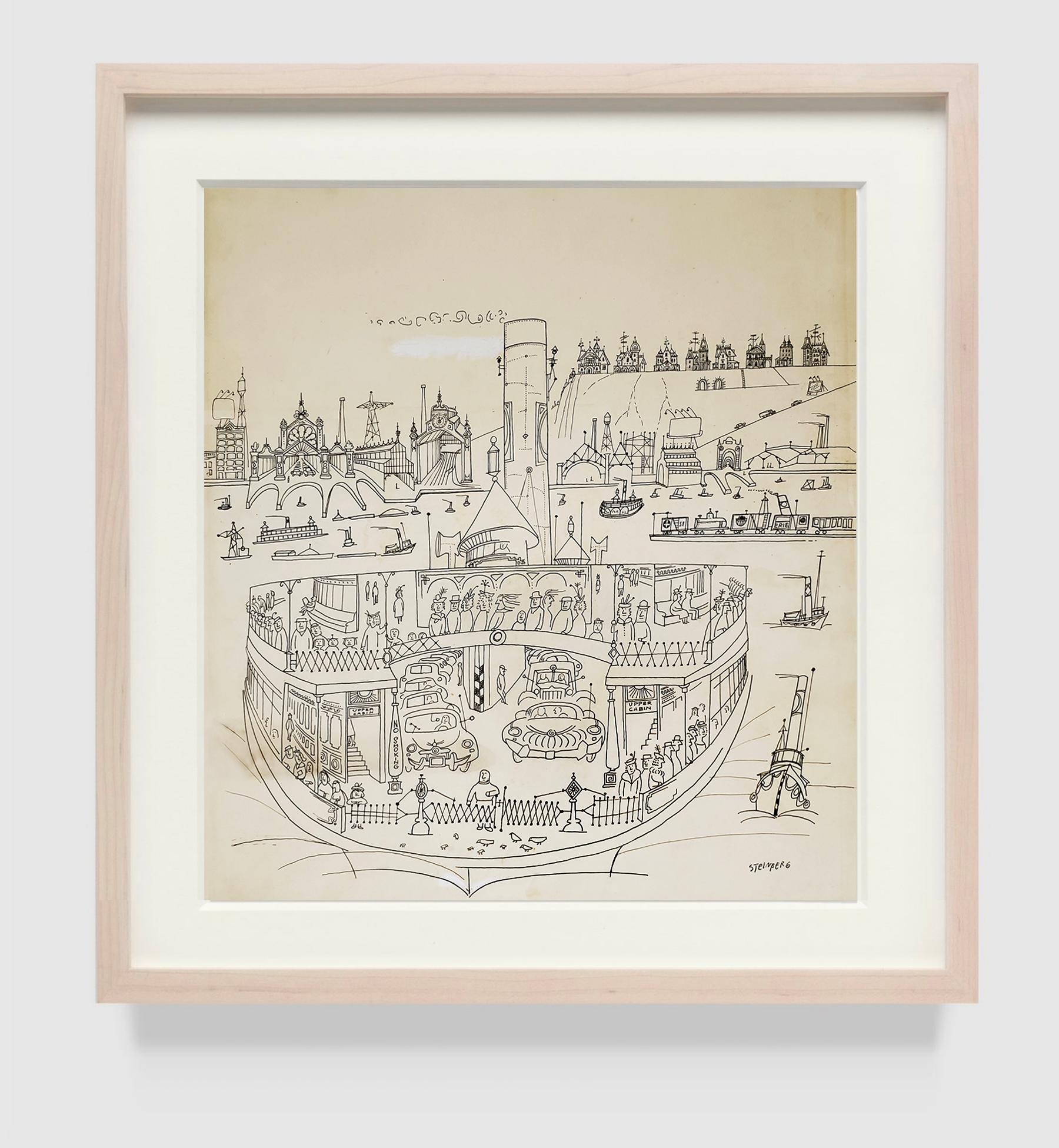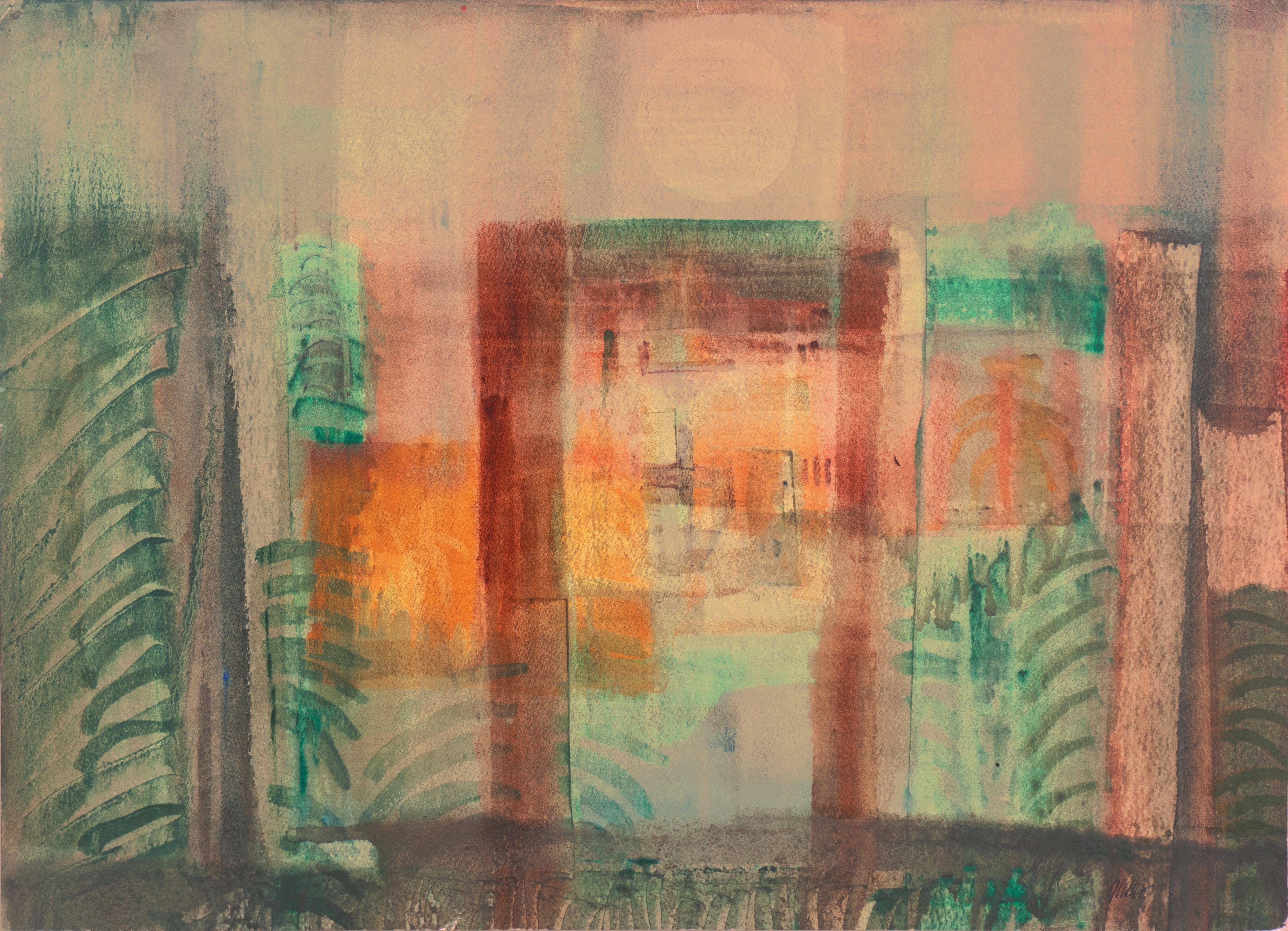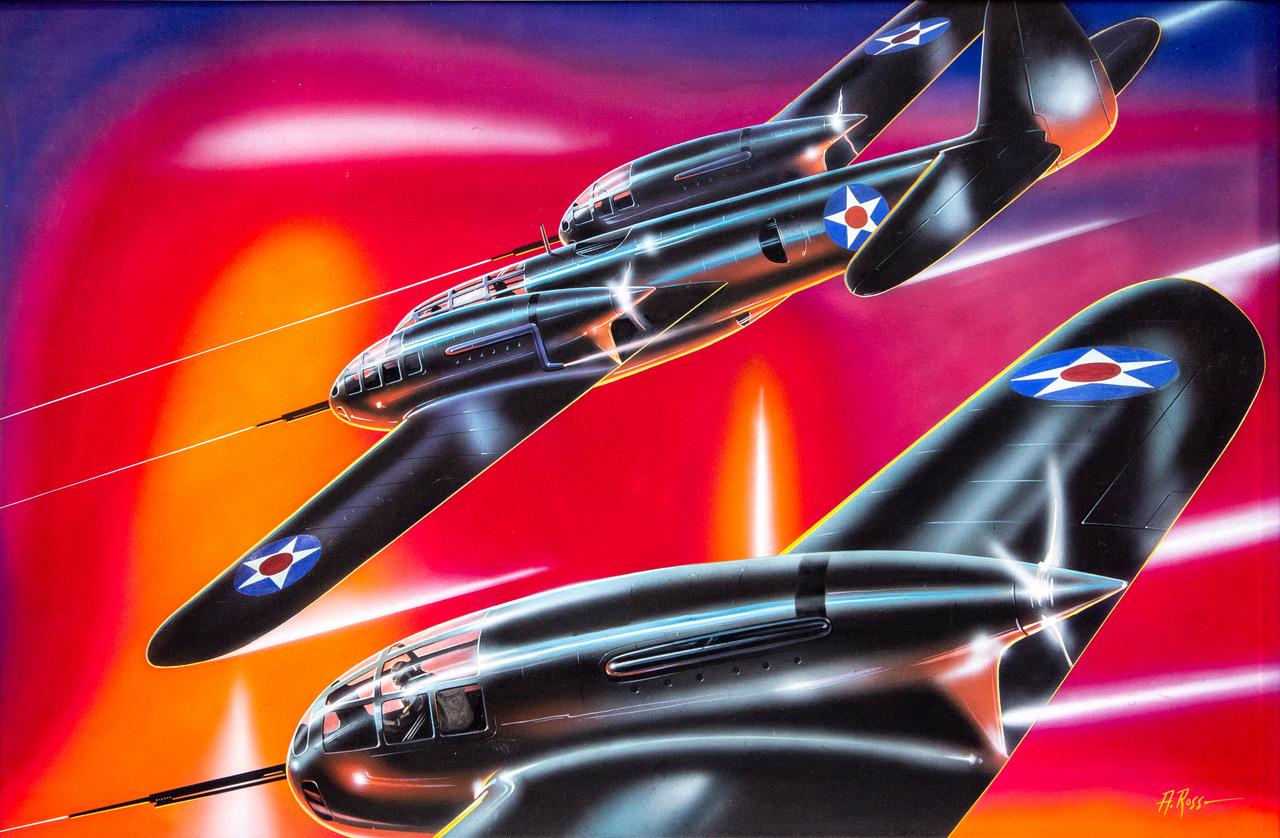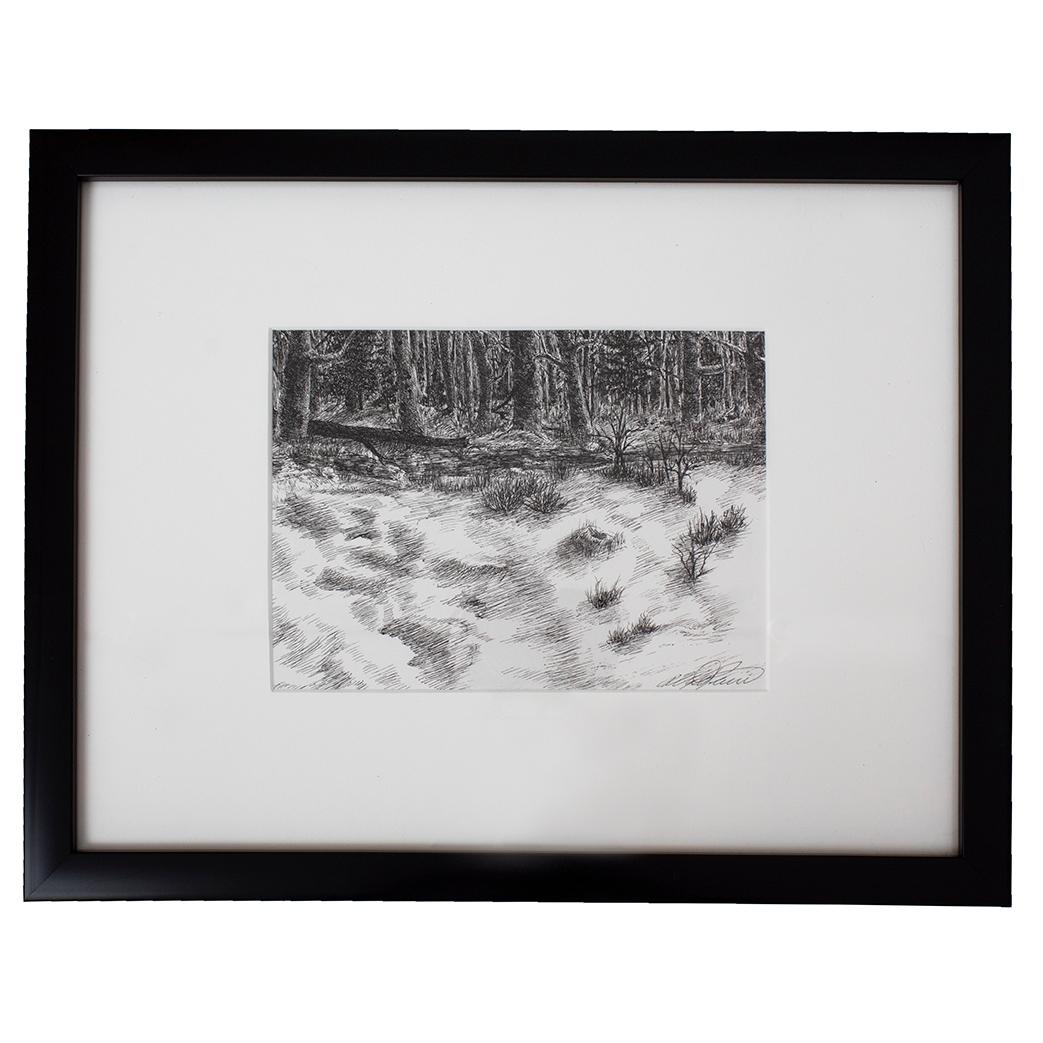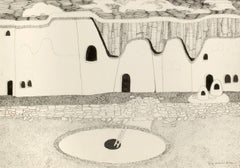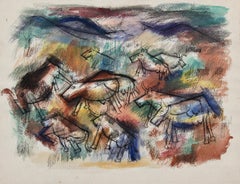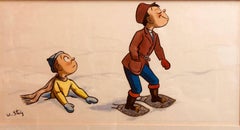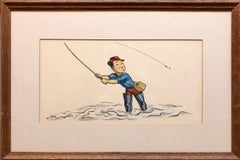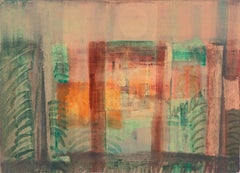Items Similar to untitled (Pueblo)
Want more images or videos?
Request additional images or videos from the seller
1 of 9
Virginia Dehnuntitled (Pueblo)20th Century
20th Century
About the Item
Untitled (Taos Pueblo)
Ink on paper, 1985-1990
Signed by the artist in ink lower right (see photo)
An early New Mexico period work, created shortly after the artist moved from New York.
Provenance: estate of the artist
Dehn Heirs
Condition: Excellent
Image/sheet size: 13 1/8 x 18 1/2 inches
Virginia Dehn
From Wikipedia, the free encyclopedia
Virginia Dehn
Virginia Dehn in her studio in Santa Fe
Virginia Dehn (née Engleman) (October 26, 1922 – July 28, 2005) was an American painter and printmaker. Her work was known for its interpretation of natural themes in almost abstract forms. She exhibited in shows and galleries throughout the U.S. Her paintings are included in many public collections.
Life
Dehn was born in Nevada, Missouri on October 26, 1922.] Raised in Hamden, Connecticut, she studied at Stephens College in Columbia, Missouri before moving to New York City. She met the artist Adolf Dehn while working at the Art Students League. They married in November 1947. The two artists worked side by side for many years, part of a group of artists who influenced the history of 20th century American art. Their Chelsea brownstone was a place where artists, writers, and intellectuals often gathered.
Early career
Virginia Dehn studied art at Stephens College in Missouri before continuing her art education at the Traphagen School of Design, and, later, the Art Students League, both located in New York City. In the mid-1940s while working at the Associated American Artists gallery, she met lithographer and watercolorist Adolf Dehn. Adolf was older than Virginia, and he already enjoyed a successful career as an artist. The two were married in 1947 in a private ceremony at Virginia's parents house in Wallingford, Connecticut.
Virginia and Adolf Dehn
The Dehns lived in a Chelsea brownstone on West 21st Street where they worked side by side. They often hosted gatherings of other influential artists and intellectuals of the 20th century. Among their closest friends were sculptor Federico Castellón and his wife Hilda; writer Sidney Alexander and his wife Frances; artists Sally and Milton Avery; Ferol and Bill Smith, also an artist; and Lily and Georges Schreiber, an artist and writer. Bob Steed and his wife Gittel, an anthropologist, were also good friends of the Dehns. According to friend Gretchen Marple Pracht, "Virginia was a glamorous and sophisticated hostess who welcomed visitors to their home and always invited a diverse crowd of guests..." Despite their active social life, the two were disciplined artists, working at their easels nearly daily and taking Saturdays to visit galleries and view new work.
The Dehns made annual trips to France to work on lithographs at the Atelier Desjobert in Paris. Virginia used a bamboo pen to draw directly on the stone for her lithographs, which often depicted trees or still lifes. The Dehns' other travels included visits to Key West, Colorado, Mexico, and countries such as Greece, Haiti, Afghanistan, and India.
Dehn's style of art differend greatly from that of her husband, though the two sometimes exhibited together. A friend of the couple remarked, "Adolf paints landscapes; Virginia paints inscapes." Virginia Dehn generally painted an interior vision based on her feelings for a subject, rather than a literal rendition of it.] Many of her paintings consist of several layers, with earlier layers showing through. She found inspiration in the Abstract Expressionism movement that dominated the New York and Paris art scenes in the 1950s. Some of her favorite artists included Adolf Gottileb, Rothko, William Baziotes, Pomodoro, and Antonio Tapies.
Dehn most often worked with bold, vibrant colors in large formats. Her subjects were not literal, but intuitive. She learned new techniques of lithography from her husband Adolf, and did her own prints. Texture was very important to her in her work. Her art was influenced by a variety of sources. In the late 1960s she came across a book that included photographs of organic patterns of life as revealed under a microscope. These images inspired her to change the direction of some of her paintings. Other influences on Dehn's art came from ancient and traditional arts of various cultures throughout the world, including Persian miniatures, illuminated manuscripts, Dutch still life painting, Asian art, ancient Egyptian artifacts, and work by Giotto, Monet, Vuillard, Munch, and Bonnard, mixed with the modernism of the New York art scene. Her husband was a constant inspiration until his death in 1968.]
Later career
In the 1970s, Dehn began making large mixed media paintings with overlays of clay and acrylic. She moved from New York City to Santa Fe in 1985. She enjoyed the sense of space and calm there that could not be found in New York City. After moving to New Mexico, some of her paintings began to take on a sculptural quality, as she began working more with materials such as clay and metallic substances into her paintings. The metallic colors she used in some works showed her interest in the interaction of light and matter. The petroglyphs of the southwest interested her, and along with her study of ancient artifacts from Egypt and Asia. Some of her works began to feature what looked like hieroglyphics.
During her artistic career, Dehn received fellowships from Yaddo, MacDowell Colony and Ossabaw Island Project. Her work was exhibited in shows and galleries throughout the country, and her paintings are part of many public collections. A traveling show sponsored by the Albuquerque Museum of Art and History called "Layerists in Multi-media" included her paintings. She was given the Salmagundi Club prize for a still life painting in 1968 by the National Academy of Design.
In her later years, Dehn continued to create as she retained a circle of devoted friends and admirers. Despite health struggles, she kept painting until her death at her home in Santa Fe on July 26, 2005. Her work is currently represented by Thomas French Fine Art and the Bundy Modern.
- Creator:Virginia Dehn (1922 - 2005, American)
- Creation Year:20th Century
- Dimensions:Height: 13.13 in (33.36 cm)Width: 18.5 in (46.99 cm)
- Medium:
- Movement & Style:
- Period:
- Condition:
- Gallery Location:Fairlawn, OH
- Reference Number:Seller: AD083421stDibs: LU1409940972
About the Seller
5.0
Recognized Seller
These prestigious sellers are industry leaders and represent the highest echelon for item quality and design.
Platinum Seller
These expertly vetted sellers are 1stDibs' most experienced sellers and are rated highest by our customers.
Established in 1978
1stDibs seller since 2013
724 sales on 1stDibs
Typical response time: <1 hour
Associations
International Fine Print Dealers Association
- ShippingRetrieving quote...Ships From: Fairlawn, OH
- Return PolicyA return for this item may be initiated within 10 days of delivery.
Authenticity Guarantee
In the unlikely event there’s an issue with an item’s authenticity, contact us within 1 year for a full refund. DetailsMoney-Back Guarantee
If your item is not as described, is damaged in transit, or does not arrive, contact us within 7 days for a full refund. Details24-Hour Cancellation
You have a 24-hour grace period in which to reconsider your purchase, with no questions asked.Vetted Professional Sellers
Our world-class sellers must adhere to strict standards for service and quality, maintaining the integrity of our listings.Price-Match Guarantee
If you find that a seller listed the same item for a lower price elsewhere, we’ll match it.Trusted Global Delivery
Our best-in-class carrier network provides specialized shipping options worldwide, including custom delivery.More From This Seller
View AllUntitled (Hot Air Baloon Ascent and Spectators)
By Joseph O'Sickey
Located in Fairlawn, OH
Untitled (Hot Air Balloon Ascent and Spectators)
Sepia wash on wove paper, 1985
Signed and dated in ink lower right corner
From the artist's 1985 sketchbook
Probably a view of Cape C...
Category
1980s American Modern Landscape Drawings and Watercolors
Materials
Ink
untitled (Pueblo)
By Virginia Dehn
Located in Fairlawn, OH
Untitled (Taos Pueblo)
Ink on paper, 1985-1990
Signed by the artist in ink lower right (see photo)
An early New Mexico period work, created shortly after the artist moved from New Yo...
Category
Early 20th Century American Modern Landscape Drawings and Watercolors
Materials
Ink
Cows in a Field (Recto) Two Figures in an Interior (Verso)
By Louis Schanker
Located in Fairlawn, OH
Cows in a Field (Recto)
Two Figures in an Interior (Verso)
Watercolor on heavy textured paper, 1938
Signed in ink verso image of Two Figures, unsigned ...
Category
1930s American Modern Landscape Drawings and Watercolors
Materials
Watercolor
Landscape with buildings and trees
By Leon Kelly
Located in Fairlawn, OH
Landscape with buildings and trees
Watercolor on paper, c. 1930's
Signed in pencil lower right (see photo)
Provenance: Estate of the artist
Condition: Excellent
Sheet size: 9 3/8 x 1...
Category
1930s American Modern Landscape Drawings and Watercolors
Materials
Watercolor
Trees Over the Vineyard
By Robert Hallowell
Located in Fairlawn, OH
Trees Over the Vineyard
Watercolor on heavy paper, c. 1930
Signed with the estate stamp verso (see photo)
Sheet size: 16 1/2 x 19 1/8 inches
Condition: Excellent
Illustrated: Marbell...
Category
1930s American Modern Landscape Drawings and Watercolors
Materials
Watercolor
Brookdale, New Jersey
By Oscar Florianus Bluemner
Located in Fairlawn, OH
Brookdale, New Jersey
Graphite on paper, 1922
Signed with the artist's initials l.l., and dated 1922 (see photo)
Annotated "Brookdale" front and back of she...
Category
1920s American Modern Landscape Drawings and Watercolors
Materials
Graphite
You May Also Like
Whimsical Illustration "Snow" Cartoon, 1938 Mt Tremblant Ski Lodge William Steig
By William Steig (b.1907)
Located in Surfside, FL
Lighthearted Illustration of Outdoor Pursuits This one being cross country Snow Shoes signed "W. Steig"
Provenance: from Mrs. Joseph B. Ryan, Commissioned by ...
Category
1930s American Modern Figurative Drawings and Watercolors
Materials
India Ink, Watercolor, Illustration Board
Whimsical Fishing Illustration Cartoon 1938 Mt Tremblant Ski Lodge William Steig
By William Steig (b.1907)
Located in Surfside, FL
Lighthearted Illustration of Outdoor Pursuits This one of a fisherman signed "W. Steig"
Provenance: from Mrs. Joseph B. Ryan, Commissioned by Joe Ryan for the bar at his ski resort, Mount Tremblant Lodge, in 1938.
Mont Tremblant, P.Q., Canada
Watercolor and ink on illustration board, sights sizes 8 1/2 x 16 1/2 in., framed.
In 1938 Joe Ryan, described as a millionaire from Philadelphia, bushwhacked his way to the summit of Mont Tremblant and was inspired to create a world class ski resort at the site. In 1939 he opened the Mont Tremblant Lodge, which remains part of the Pedestrian Village today. This original illustration is on Whatman Illustration board. the board measures 14 X 22 inches. label from McClees Galleries, Philadelphia, on the frame backing paper.
William Steig, 1907 – 2003 was an American cartoonist, sculptor, and, in his later life, an illustrator and writer of children's books. Best known for the picture books Sylvester and the Magic Pebble, Abel's Island, and Doctor De Soto, he was also the creator of Shrek!, which inspired the film series of the same name. He was the U.S. nominee for both of the biennial, international Hans Christian Andersen Awards, as a children's book illustrator in 1982 and a writer in 1988.
Steig was born in Brooklyn, New York in 1907, and grew up in the Bronx. His parents were Polish-Jewish immigrants from Austria, both socialists. His father, Joseph Steig, was a house painter, and his mother, Laura Ebel Steig, was a seamstress who encouraged his artistic leanings. As a child, he dabbled in painting and was an avid reader of literature. Among other works, he was said to have been especially fascinated by Pinocchio.He graduated from Townsend Harris High School at 15 but never completed college, though he attended three, spending two years at City College of New York, three years at the National Academy of Design and a mere five days at the Yale School of Fine Arts before dropping out of each.
Hailed as the "King of Cartoons" Steig began drawing illustrations and cartoons for The New Yorker in 1930, producing more than 2,600 drawings and 117 covers for the magazine. Steig, later, when he was 61, began writing children's books. In 1968, he wrote his first children's book. He excelled here as well, and his third book, Sylvester and the Magic Pebble (1969), won the Caldecott Medal. He went on to write more than 30 children's books, including the Doctor DeSoto series, and he continued to write into his nineties. Among his other well-known works, the picture book Shrek! (1990) formed the basis for the DreamWorks Animation film Shrek (2001). After the release of Shrek 2 in 2004, Steig became the first sole-creator of an animated movie franchise that went on to generate over $1 billion from theatrical and ancillary markets after only one sequel. Along with Maurice Sendak, Saul Steinberg, Ludwig Bemelmans and Laurent de Brunhofff his is one of those rare cartoonist whose works form part of our collective cultural heritage.
In 1984, Steig's film adaptation of Doctor DeSoto directed by Michael Sporn was nominated for the Academy Award for Best Animated Short Film. As one of the most admired cartoonists of all time, Steig spent seven decades drawing for the New Yorker magazine. He touched generations of readers with his tongue–in–cheek pen–and–ink drawings, which often expressed states of mind like shame, embarrassment or anger. Later in life, Steig turned to children's books, working as both a writer and illustrator.
Steig's children's books were also wildly popular because of the crazy, complicated language he used—words like lunatic, palsied, sequestration, and cleave. Kids love the sound of those words even if they do not quite understand the meaning. Steig's descriptions were also clever. He once described a beached whale as "breaded with sand."
Throughout the course of his career, Steig compiled his cartoons and drawings into books. Some of them were published first in the New Yorker. Others were deemed too dark to be printed there. Most of these collections centered on the cold, dark psychoanalytical truth about relationships. They featured husbands and wives fighting and parents snapping at their kids. His first adult book, Man About Town, was published in 1932, followed by About People, published in 1939, which focused on social outsiders. Sick of Each Other, published in 2000, included a drawing depicting a wife holding her husband at gunpoint, saying, "Say you adore me."
According to the Los Angeles Times, fellow New Yorker artist...
Category
1930s American Modern Figurative Drawings and Watercolors
Materials
India Ink, Watercolor, Illustration Board
New York Harbor with Ferry boats and Victorian Houses - Holiday Magazine Cover
By Saul Steinberg
Located in Miami, FL
Steinberg's Holiday Magazine Cover, " The North of Jersey " is similar to his famous New Yorker Cover "View of the World from 9th Avenue”. ...
Category
1950s American Modern Landscape Drawings and Watercolors
Materials
India Ink, Gouache
'Evening Landscape' Bay Area Abstraction, San Francisco Museum of Fine Arts, CWS
By Robert George Gilberg
Located in Santa Cruz, CA
Signed lower right, 'Gilberg' for Robert George Gilberg (American, 1911-1970) and painted circa 1965.
Born in Oakland, Robert George Gilberg first studied at the Oakland Art Center during the 1930s. Following service during WWII, he settled in Nevada City, California where he lived and painted until shortly before his death in San Francisco. Gilberg exhibited widely and with success and was the recipient of numerous medals, prizes and juried awards, including at the San Francisco Museum of Fine Arts...
Category
1960s American Modern Landscape Drawings and Watercolors
Materials
Paper, Ink, Watercolor
Airacuda Fighter Planes Art Deco Machine Age 20th Century American Modernism
Located in New York, NY
Airacuda Fighter Planes Art Deco Machine Age 20th Century American Modernism
Arthur Rosenman Ross (1913 - 1981)
Bell YFM-1 Airacuda Fighter Planes
17 1/2 x 26 1/2 inches
Gouache, Airbrush and Ink on Illustration Board, 1938
Signed A. Ross lower right
Provenance: Estate of the artist.
BIO
Arthur Rosenman Ross was a key figure in automotive design at General Motors during America's "Golden Age" of auto design, the 1930's through the 1950s.
He attended the Art Institute of Chicago from age 17, exhibiting a special interest for automotive renderings and the female figure.
In 1934, he changed his name from Rosenman to Ross, fearing his Jewish ancestry could prejudice his career prospects. At age 20, he turned down job offers from MGM Studios in Hollywood
and Duesenberg to work at General Motors alongside the Legendary Harley Earl in 1935.
He was hand picked by Mr. Earl and assigned to GM's War and Camouflage Division in 1937 through WW2.
It was during this pivotal period in which he executed some extraordinary military aircraft artworks, likely used between GM and America's military aeronautics companies in design preparation for WW2. General Motors played an important role in helping America's aircraft manufacturers preceding and during the war.
Just after the war in 1945, Mr. Ross was rewarded by GM, being made Chief Designer of Cadillac, then two years later becoming Chief at Oldsmobile until his retirement in 1959.
He was in large part responsible for some of GM's classic Cadillac designs such as the Cadillac Sixty Special, Fleetwood, LaSalle and GM's first concept car, the extraordinary Buick Y-Job.
Mr. Ross was an exceptionally charismatic and vivacious man who quite by chance, befriended His idol, Salvador Dali at GM in 1955.
They talked about art, cars and girls late into the evening, according to his son, Carter Ross.
He had a gift in rendering the erotic arts...
Category
1930s American Modern Landscape Drawings and Watercolors
Materials
Ink, Gouache, Board
Untitled (Landscape #20)
Located in Albuquerque, NM
Alex Peña, Untitled (Landscape #20), 2021, ink on paper
Framed size: 12" x 14"
Image size: 5.75" x 7.5"
Category
2010s American Modern Landscape Drawings and Watercolors
Materials
Ink
Recently Viewed
View AllMore Ways To Browse
Virginia Artists
Virginia City
Virginia Study
Virginia Paris
October 26
Watercolor Landscapes Colorado
Watercolor Easel
Watercolor Prints Trees
Southwest Landscapes Photograph
Mexican Pueblo
Asian Antique Watercolor
Pueblo Painting
Bill Smith
Antique Persian Painting
20th Century Manuscripts
Mexico Easel
Thomas Holland Painting
The Stone House Watercolour
